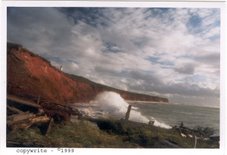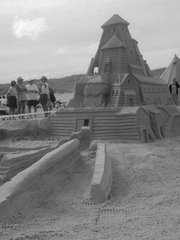Magdalen Islands Drinking Water
 A vast operation to dig for drinking water has been underway for two weeks now here on the Magdalen Islands. The objective of the work is to guarantee the provision of drinking water for the next 30 years.
A vast operation to dig for drinking water has been underway for two weeks now here on the Magdalen Islands. The objective of the work is to guarantee the provision of drinking water for the next 30 years.Hydro-geologists, who are now here must dig 33 wells 200 feet deep between now and November. “What we want, is to determine the zones where we can dig the wells to connect to the [aqueduct] network already existing on the island of Grindstone with that on the island of House Harbour,” explained the Mayor of the Iles-de-la-Madeleine Municipality, Joël Arseneau.
Eleven wells will be put into production and branched to the aqueduct network over the course of the next year. The 22 other wells will serve for observation points, said engineer, Denis Richard, president of the firm, AGEOS. “We’re digging holes and we're measuring the evolution of the ground water, the depth and the pumping function that we can do from the production wells.”
The drinking water reserves of the ground water on the Islands, is precious and it must be managed with prudence. The pressure exercised on the aqueduct network and the production of the fish factories necessitates this additional production of potable water.
It is foreseen that in one well only, the island of Grindstone will need from 300 to 500 gallons of additional water per minute in 30 years. The contract of one million dollars for the work has been given to the consortium, Madelin’Eau.
It seems to me that, if anything, the municipality is destroying their own drinking water. How many times over the past few years have they say that the water table cannot take the drainage that 'we', the people of the Islands keep taking from it. The geologists have publicly said that there is a tender balance between the fresh water table and the salt water of the Gulf. That if we remove the ground water before it can replenish itself with melting snow, ice and rain, then the salt water will move it to take the place of the fresh water and eventually, we will be without drinking water.
Now I'm well aware of the nitrogen cycle and the water cycle and how the acid rain water gets filtered by the vegetation and layers of gravel it must go through to reach the water table. But if that water table turns salty then all but the most shallow vegetation, ie beach grass, will survive. It not hard to envision where that leaves the population of the Magdalen Islands.
Of course, that is enough doom and gloom. The Magdalen Islands has survived 50 million years, they can certainly survive the Municipality of the Iles-de-la-Madeleine. I hope the rest of us can.
Note: this is a blog and it is my personal opinion on the situation of the Magdalen Islands. It is not necessarily the news as it would be in a newspaper. I have never hidden the fact that I believe the Municipality of the Iles-de-la-Madeleine, for the want of a better word, stinks.





3 comments:
I do like a person who gives it straight. You'd never make a politician though!!! lol.
I would make the worst politician possible, lol. There is not a doubt about that. I believe too much in letting the people decide in what's best for themselves, Dickiebo.
Wynn
Fatal, fatal error for any politician!!!
Post a Comment